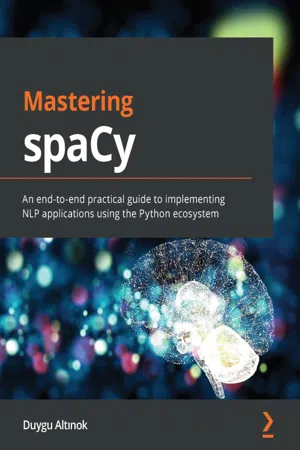
- 356 pages
- English
- ePUB (mobile friendly)
- Available on iOS & Android
Mastering spaCy
About this book
Build end-to-end industrial-strength NLP models using advanced morphological and syntactic features in spaCy to create real-world applications with easeKey Features• Gain an overview of what spaCy offers for natural language processing• Learn details of spaCy's features and how to use them effectively• Work through practical recipes using spaCyBook DescriptionspaCy is an industrial-grade, efficient NLP Python library. It offers various pre-trained models and ready-to-use features. Mastering spaCy provides you with end-to-end coverage of spaCy's features and real-world applications.You'll begin by installing spaCy and downloading models, before progressing to spaCy's features and prototyping real-world NLP apps. Next, you'll get familiar with visualizing with spaCy's popular visualizer displaCy. The book also equips you with practical illustrations for pattern matching and helps you advance into the world of semantics with word vectors. Statistical information extraction methods are also explained in detail. Later, you'll cover an interactive business case study that shows you how to combine all spaCy features for creating a real-world NLP pipeline. You'll implement ML models such as sentiment analysis, intent recognition, and context resolution. The book further focuses on classification with popular frameworks such as TensorFlow's Keras API together with spaCy. You'll cover popular topics, including intent classification and sentiment analysis, and use them on popular datasets and interpret the classification results.By the end of this book, you'll be able to confidently use spaCy, including its linguistic features, word vectors, and classifiers, to create your own NLP apps.What you will learn• Install spaCy, get started easily, and write your first Python script• Understand core linguistic operations of spaCy• Discover how to combine rule-based components with spaCy statistical models• Become well-versed with named entity and keyword extraction• Build your own ML pipelines using spaCy• Apply all the knowledge you've gained to design a chatbot using spaCyWho this book is forThis book is for data scientists and machine learners who want to excel in NLP as well as NLP developers who want to master spaCy and build applications with it. Language and speech professionals who want to get hands-on with Python and spaCy and software developers who want to quickly prototype applications with spaCy will also find this book helpful. Beginner-level knowledge of the Python programming language is required to get the most out of this book. A beginner-level understanding of linguistics such as parsing, POS tags, and semantic similarity will also be useful.
Frequently asked questions
- Essential is ideal for learners and professionals who enjoy exploring a wide range of subjects. Access the Essential Library with 800,000+ trusted titles and best-sellers across business, personal growth, and the humanities. Includes unlimited reading time and Standard Read Aloud voice.
- Complete: Perfect for advanced learners and researchers needing full, unrestricted access. Unlock 1.4M+ books across hundreds of subjects, including academic and specialized titles. The Complete Plan also includes advanced features like Premium Read Aloud and Research Assistant.
Please note we cannot support devices running on iOS 13 and Android 7 or earlier. Learn more about using the app.
Information
Section 1: Getting Started with spaCy
- Chapter 1, Getting Started with spaCy
- Chapter 2, Core Operations with spaCy
Chapter 1: Getting Started with spaCy
- Overview of spaCy
- Installing spaCy
- Installing spaCy's statistical models
- Visualization with displaCy
Technical requirements
Overview of spaCy
Rise of NLP

Table of contents
- Mastering spaCy
- Contributors
- Preface
- Section 1: Getting Started with spaCy
- Chapter 1: Getting Started with spaCy
- Chapter 2: Core Operations with spaCy
- Section 2: spaCy Features
- Chapter 3: Linguistic Features
- Chapter 4: Rule-Based Matching
- Chapter 5: Working with Word Vectors and Semantic Similarity
- Chapter 6: Putting Everything Together: Semantic Parsing with spaCy
- Section 3: Machine Learning with spaCy
- Chapter 7: Customizing spaCy Models
- Chapter 8: Text Classification with spaCy
- Chapter 9: spaCy and Transformers
- Chapter 10: Putting Everything Together: Designing Your Chatbot with spaCy
- Other Books You May Enjoy